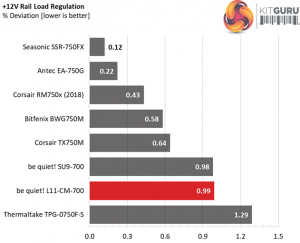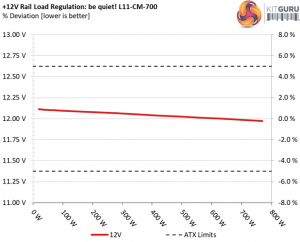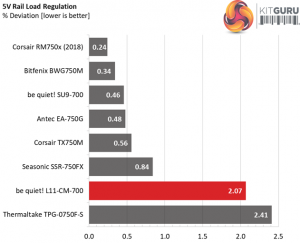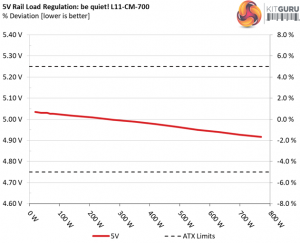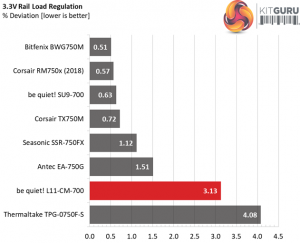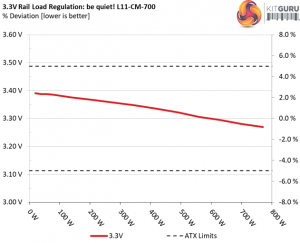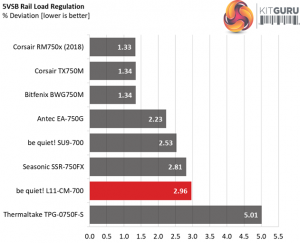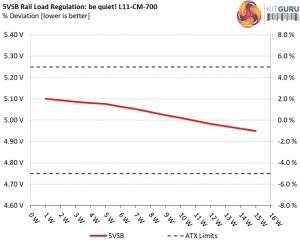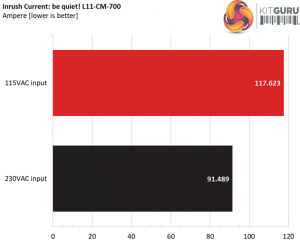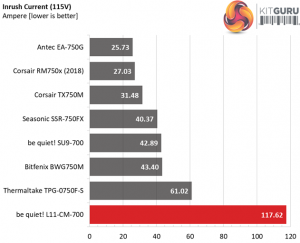To learn more about our PSU tests and methodology, please check out How We Test Power Supply Units.
Primary Rails And 5VSB Load Regulation
Load Regulation testing is detailed here.
Hold-Up Time
Our hold-up time tests are described in detail here.
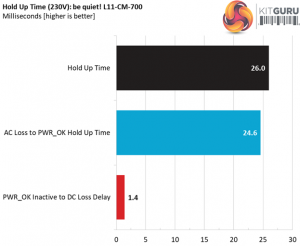
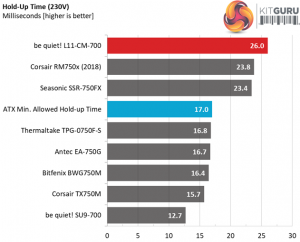
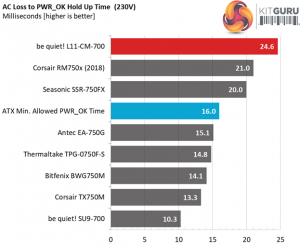
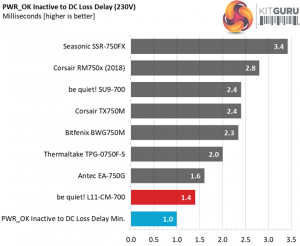
The oscilloscope screenshots that we took during the hold-up time measurements:
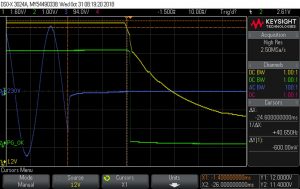
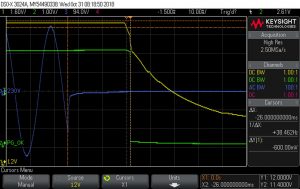
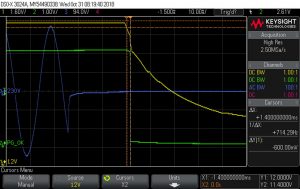
The hold-up time is long, something that we expected because of the ACRF topology, and the power ok signal is accurate.
Inrush Current
For details on our inrush current testing, please click here.
We measure very high inrush currents, with both voltage inputs. The NTC thermistor, responsible for lowering those currents, is small and on top of that it is not supported by a bypass relay, so it gets hot soon and its resistance drops.
Load Regulation And Efficiency Measurements
The first set of tests reveals the stability of the voltage rails and the L11-CM-700’s efficiency. The applied load equals (approximately) 10 to 110 percent of the power supplies maximum load in increments of 10 percentage points.
We conducted two additional tests.
During the first, we stressed the two minor rails (5V and 3.3V) with a high load, while the load at +12V was only 0.1A. This test reveals whether a power supply is compatible with Intel’s C6/C7 sleep states or not. In the second test, we determined the maximum load the +12V rail could handle with minimal load on the minor rails.
| Test # | 12V | 5V | 3.3V | 5VSB | DC/AC (Watts) | Efficiency | Fan Speed (RPM) | PSU Noise (dB[A]) | Temps (In/Out) | PF/AC Volts |
| 1 | 3.971A | 1.990A | 1.948A | 0.985A | 69.651 | 86.337% | 685 | 12.5 | 40.04°C | 0.915 |
| 12.101V | 5.026V | 3.386V | 5.077V | 80.673 | 44.95°C | 115.05V | ||||
| 2 | 9.002A | 2.991A | 2.933A | 1.185A | 139.723 | 90.135% | 687 | 12.1 | 40.45°C | 0.948 |
| 12.088V | 5.017V | 3.375V | 5.064V | 155.015 | 45.72°C | 115.05V | ||||
| 3 | 14.378A | 3.495A | 3.415A | 1.386A | 209.635 | 91.060% | 687 | 12.1 | 41.26°C | 0.968 |
| 12.076V | 5.009V | 3.367V | 5.052V | 230.217 | 46.74°C | 115.05V | ||||
| 4 | 19.764A | 4.003A | 3.932A | 1.588A | 279.657 | 91.198% | 689 | 11.2 | 41.88°C | 0.979 |
| 12.065V | 4.997V | 3.357V | 5.038V | 306.649 | 47.84°C | 115.04V | ||||
| 5 | 24.829A | 5.013A | 4.928A | 1.791A | 349.737 | 90.811% | 692 | 11.1 | 42.54°C | 0.987 |
| 12.052V | 4.988V | 3.347V | 5.024V | 385.125 | 48.86°C | 115.04V | ||||
| 6 | 29.908A | 6.027A | 5.934A | 1.996A | 419.850 | 90.217% | 693 | 10.9 | 42.97°C | 0.991 |
| 12.039V | 4.977V | 3.335V | 5.011V | 465.380 | 50.52°C | 115.04V | ||||
| 7 | 34.993A | 7.052A | 6.956A | 2.202A | 489.979 | 89.479% | 789 | 14.0 | 43.22°C | 0.992 |
| 12.027V | 4.964V | 3.322V | 4.997V | 547.594 | 52.08°C | 115.03V | ||||
| 8 | 40.096A | 8.081A | 7.984A | 2.409A | 560.070 | 88.639% | 1047 | 19.1 | 43.89°C | 0.993 |
| 12.013V | 4.950V | 3.306V | 4.982V | 631.853 | 53.30°C | 115.03V | ||||
| 9 | 45.607A | 8.606A | 8.497A | 2.414A | 629.791 | 87.761% | 1270 | 25.1 | 44.55°C | 0.994 |
| 12.000V | 4.939V | 3.295V | 4.973V | 717.623 | 54.54°C | 115.03V | ||||
| 10 | 50.897A | 9.137A | 9.053A | 3.031A | 699.814 | 86.678% | 1476 | 29.4 | 45.19°C | 0.995 |
| 11.987V | 4.926V | 3.281V | 4.949V | 807.369 | 56.29°C | 115.03V | ||||
| 11 | 56.801A | 9.156A | 9.081A | 3.037A | 769.846 | 85.389% | 1712 | 33.5 | 46.98°C | 0.993 |
| 11.974V | 4.916V | 3.270V | 4.941V | 901.578 | 58.52°C | 115.02V | ||||
| CL1 | 0.139A | 18.004A | 18.000A | 0.000A | 151.169 | 82.350% | 906 | 17.7 | 42.94°C | 0.958 |
| 12.068V | 4.967V | 3.337V | 5.063V | 183.568 | 48.88°C | 115.05V | ||||
| CL2 | 56.005A | 1.002A | 1.001A | 1.000A | 685.276 | 86.822% | 1496 | 29.9 | 45.73°C | 0.994 |
| 11.999V | 4.949V | 3.300V | 5.009V | 789.287 | 56.46°C | 115.03V |
The load regulation at +12V cannot compete with units that feature half or full-bridge topologies, however still it is within 1% so it is satisfactory. The voltage deviations on the rest rails are notable, under increased loads.
The registered efficiency levels meet the corresponding 80 PLUS Gold requirements with 20% and 50% of the unit's max-rated load, while with full load efficiency cannot reach 87%. Nonetheless, we apply a huge stress with an over 45°C ambient, so inevitably the PSU's efficiency takes a big hit.
Despite of the 40°C rating, we cranked up the heat inside the hotbox at up to 47°C and everything went smooth. Even under very tough conditions the cooling fan spins at low speeds, with the output noise remaining at equally low levels.
 KitGuru KitGuru.net – Tech News | Hardware News | Hardware Reviews | IOS | Mobile | Gaming | Graphics Cards
KitGuru KitGuru.net – Tech News | Hardware News | Hardware Reviews | IOS | Mobile | Gaming | Graphics Cards


